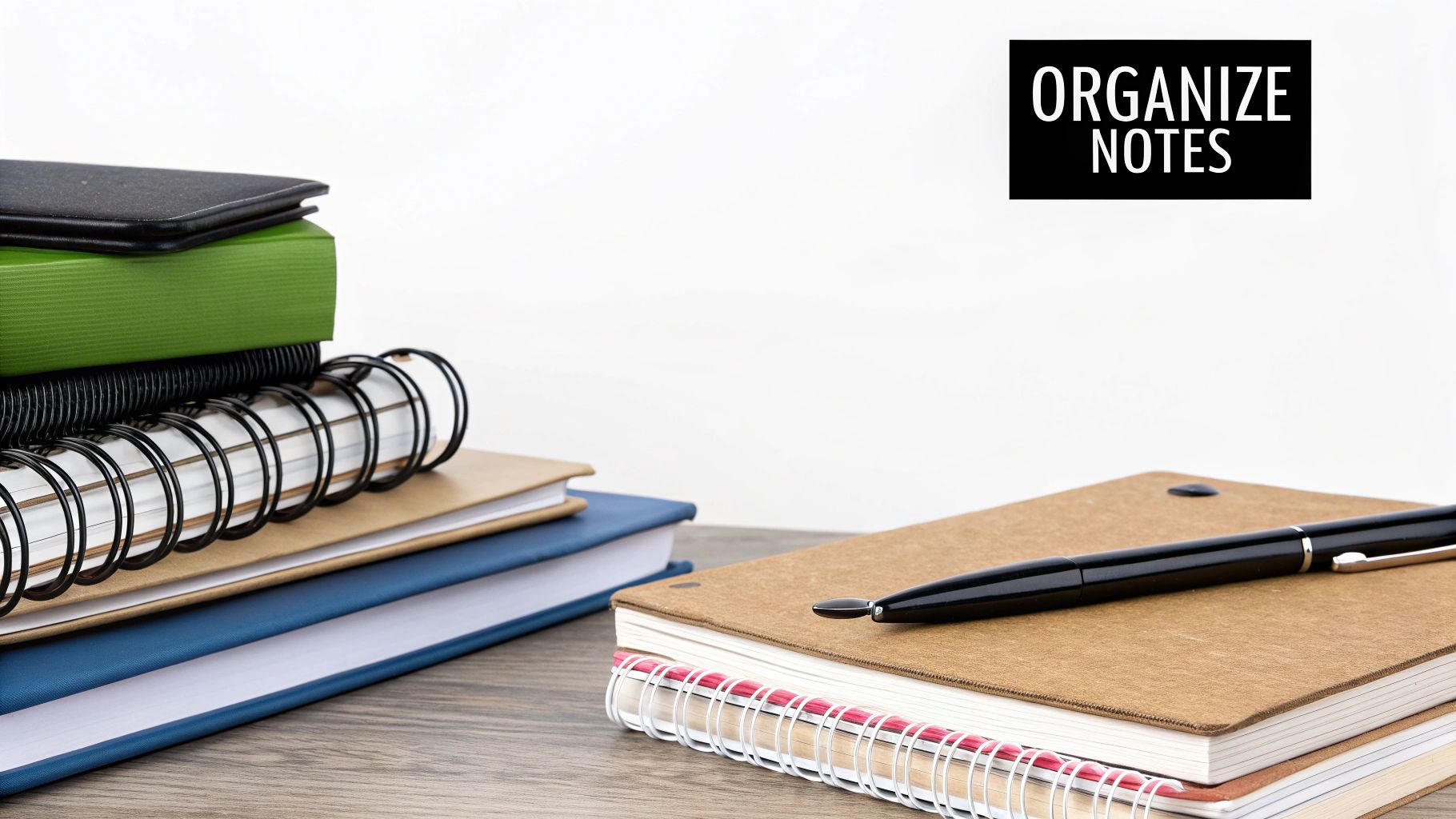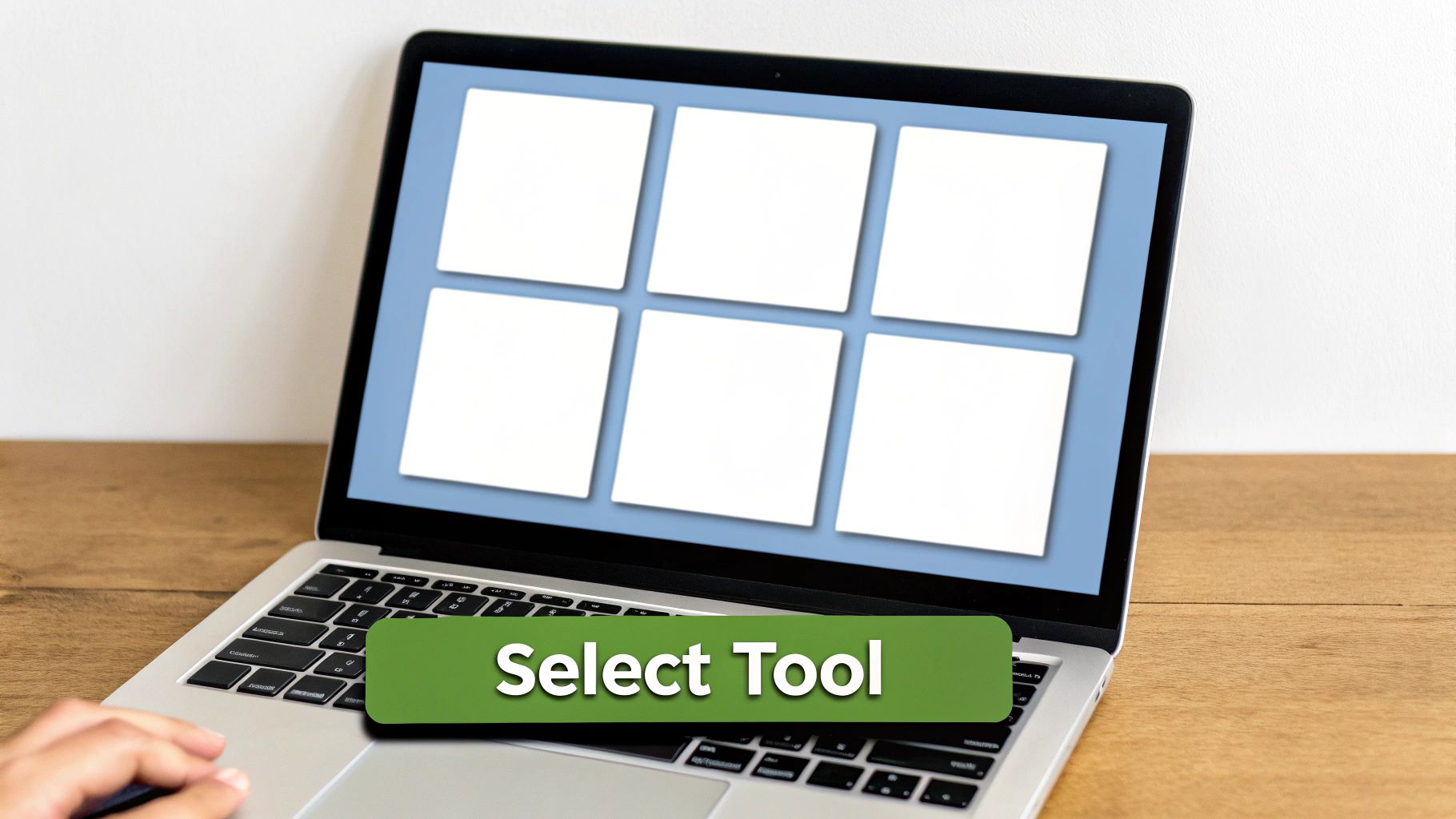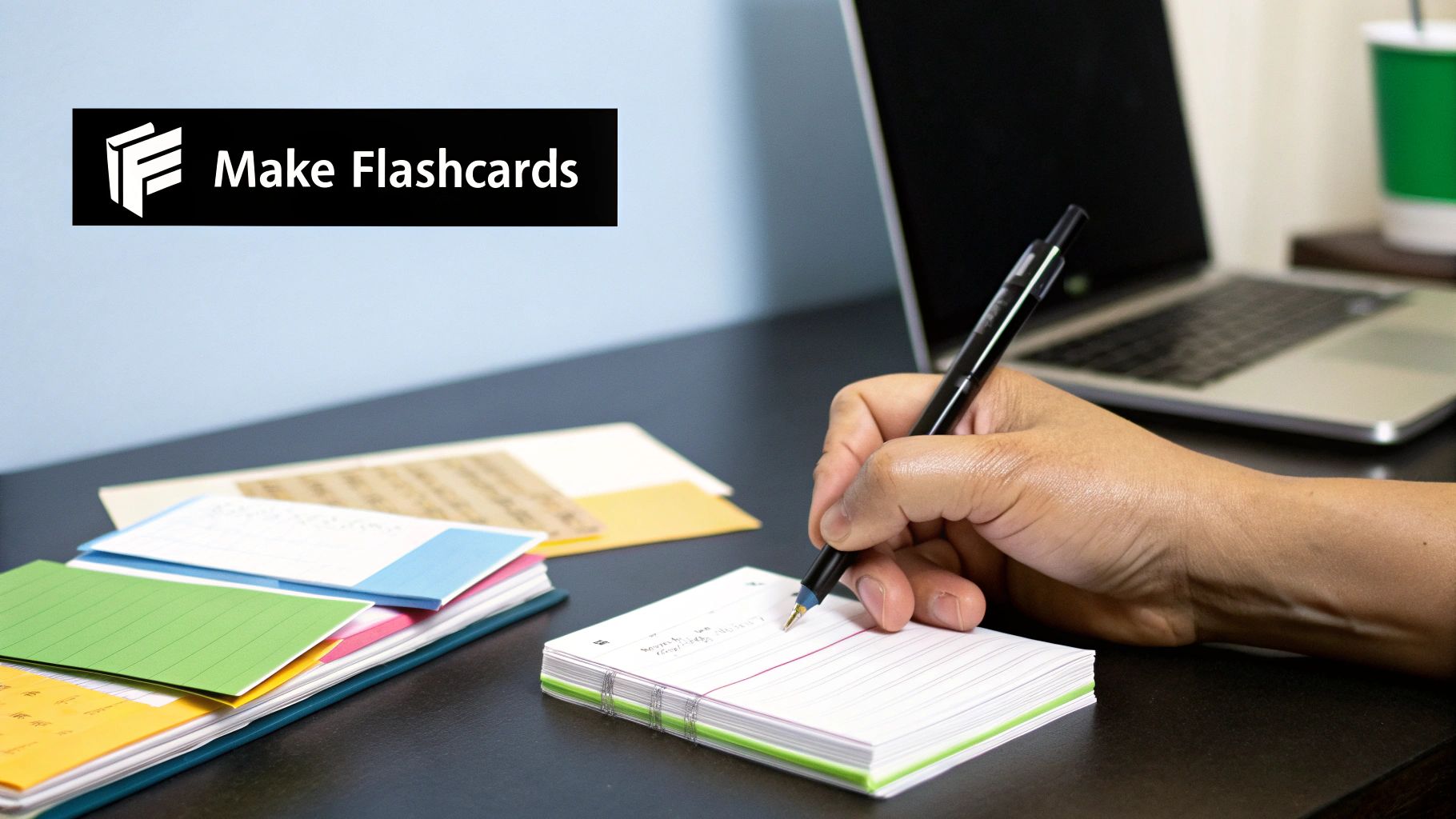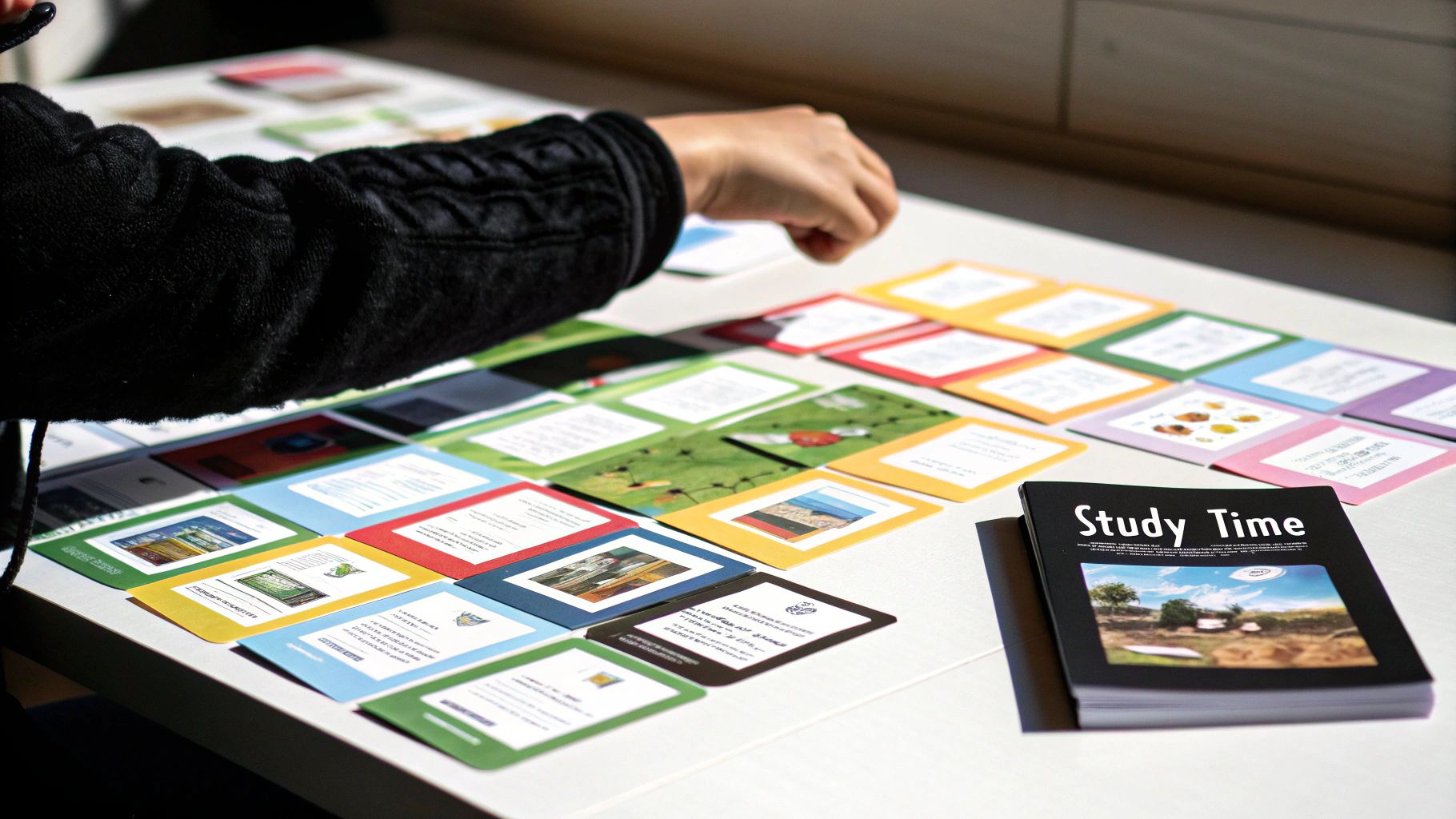You know that feeling of staring at a page of notes, rereading it for the tenth time, and hoping it sticks? We've all been there. The problem is, passive rereading is one of the least effective ways to learn. It creates an "illusion of competence" where your brain recognizes the material but can't actually recall it when it matters.
This is where turning those notes into flashcards becomes a total game-changer. It forces you to switch from being a passive reader to an active participant in your own learning.
Why Turning Notes Into Flashcards Is a Learning Game-Changer

When you just glance over your notes, your brain gets lazy. It sees familiar words and thinks, "Yep, I know this." But recognizing isn't the same as knowing. To truly learn something, you need to be able to pull that information out of your head from scratch, without any hints.
The Power of Active Recall
Creating flashcards makes you process your notes on a much deeper level. You can't just copy and paste; you have to pinpoint the most critical concepts and distill them into a concise question-and-answer format. That process alone is a powerful learning exercise.
Then comes the review. Every time you flip a card and try to answer the question, you're performing a mini-test. This is called active recall (or retrieval practice), and it's like doing a rep at the gym for your brain. It strengthens the neural connections for that specific piece of information, making it easier to access later on.
The real magic isn't in the flashcard itself, but in the mental effort required to retrieve the answer. That struggle is what builds durable memory.
Preparing for Spaced Repetition
Flashcards are also the perfect tool for spaced repetition, a powerhouse technique where you review material at increasing intervals over time. By turning your notes into a deck of cards, you've created the ideal setup for this highly efficient system.
Instead of cramming everything at once, you can study strategically. You'll focus your energy on the concepts you find tricky while spending less time on the ones you've already nailed down.
It’s no surprise that this method has caught on. The global flash cards market was valued at about USD 8.2 billion in 2024 and is projected to hit nearly USD 12.7 billion by 2033. This massive growth just goes to show how essential flashcards—both physical and digital—have become for effective learning around the world. You can learn more about these market trends from DataHorizzon Research.
How to Structure Your Notes for Effortless Conversion

Before you can magically turn your notes into flashcards, we need to talk about the quality of your source material. Let's be honest: a poorly organized document is only going to give you confusing, ineffective flashcards. The real secret is to structure your notes for conversion right from the start.
This screenshot shows just how simple Markdown syntax is. It uses basic characters like hashtags for headings and asterisks for lists. The idea is to use this dead-simple formatting to create a clear Q&A structure that any conversion tool can instantly understand.
Adopt an Atomic Mindset
The best flashcards are atomic—they zero in on a single, isolated concept. This means you have to break down complex topics into their smallest testable pieces. Whatever you do, avoid cramming multiple ideas onto one card. It completely undermines the power of active recall.
Instead of a huge question like "Explain photosynthesis," you’d break it down into bite-sized chunks:
- What is the chemical equation for photosynthesis?
- What are the two main stages of photosynthesis?
- Where does the Calvin cycle take place?
This approach makes sure each card tests one specific piece of knowledge. Trust me, it makes your study sessions far more focused and productive.
The rule is simple: one question, one answer. If your answer needs multiple, unrelated sentences, you should probably split it into more flashcards. That little bit of discipline when you're taking notes pays off big time when it's time to review.
Use Markdown for Universal Compatibility
Markdown is a lightweight markup language that lets you format text using simple, plain-text symbols. It's the perfect foundation for creating flashcards because it's so easy to use and works everywhere. You can get the hang of this syntax in minutes with a basic text editor or a dedicated tool. If you're looking for a great place to practice, you can explore the TNote Markdown editor.
The core principle is to use headings for your questions and bullet points or numbered lists for your answers. This creates a logical hierarchy that automated tools can read perfectly.
For example, a note about a historical event might look like this in Markdown:
### What year did the Battle of Hastings occur?
- 1066
### Who were the main combatants in the Battle of Hastings?
- The Norman-French army led by William, Duke of Normandy
- The English army led by King Harold Godwinson
This clean structure isn't just for machines; it also makes your own notes much easier to read and scan. By getting into this simple formatting habit, you ensure your notes are always prepped for a smooth, effortless conversion into a powerful deck of study cards.
Choosing Your Flashcard Creation Method

So, you've got your notes ready and want to turn them into flashcards. This is where you hit a fork in the road. The best path forward really boils down to your personal learning style, what you're studying, and—let's be honest—how much time you have.
For some people, nothing beats the classic method: pen and index cards. There's a certain magic to the physical act of writing that helps cement information in your memory. It’s a tactile experience that connects your brain to the material in a way that just clicking and typing can't always replicate.
Even with all the apps out there, physical flashcards are holding their own. The global market was valued at an impressive USD 3.5 billion in 2024 and is still growing. This trend, highlighted in a report from Verified Market Reports, shows just how many learners still rely on the old-school approach for memory retention.
Manual vs. Automated Methods
While making cards by hand has its perks, the biggest downside is the time commitment. If you’re staring down a mountain of dense notes, hand-writing every single card can quickly become a tedious chore that eats into your actual study time.
This is where digital tools and automated solutions come to the rescue. They offer a level of speed and efficiency that you simply can't get from manual methods. A good automated tool can chew through a whole document of neatly structured notes in seconds, giving you back precious time to focus on what actually matters: learning.
The goal is to find the sweet spot between effective creation and efficient studying. Your chosen method should feel like a boost to your learning process, not another chore on your to-do list.
When you look at digital tools, they generally fall into two camps: dedicated flashcard apps and automated converters.
Comparing Flashcard Creation Methods
Let's break down the common methods for turning notes into flashcards. Each has its own set of pros and cons, and the best one for you depends entirely on your goals and workflow.
| Method | Speed | Customization | Best For |
|---|---|---|---|
| Manual (Pen & Paper) | Slow | High | Tactile learners who benefit from the physical act of writing to aid memory. |
| Dedicated Apps (Anki, Quizlet) | Moderate | High | Users who want a feature-rich, all-in-one ecosystem with built-in spaced repetition. |
| Automated Conversion (TNote) | Very Fast | Moderate | Students and professionals who want to quickly convert existing Markdown notes with minimal effort. |
Ultimately, the choice comes down to integrating studying into your existing habits. If you're already a dedicated Anki user, building decks there makes sense. But if you live in your note-taking app, an automated converter is a game-changer.
Here's a closer look at the digital options:
- Dedicated Apps: Platforms like Anki or Quizlet are powerful, feature-packed environments. They're fantastic for building study decks from the ground up right inside their ecosystem, and many come with powerful spaced repetition algorithms built-in.
- Automated Converters: This is where tools like TNote’s md2card feature really shine. They're built for pure speed and simplicity, bridging the gap between your note-taking app and your study session. You can keep working where you're comfortable and then, with a click, convert your finished notes into a ready-to-study format. It’s perfect for anyone who wants to make flashcard creation a seamless part of their existing workflow.
Your Guide to Automated Flashcard Creation
Alright, with your Markdown notes all structured and ready, it's time for the fun part. This is where we turn that raw text into a polished deck of flashcards with just a couple of clicks, letting a tool like TNote’s md2card feature do the heavy lifting. Trust me, it beats the old way of manually creating cards for hours on end.
The whole process is refreshingly simple. First, you just need to get your notes into the tool. You can either upload a .md file straight from your computer or just copy and paste the text directly. This flexibility is great because it doesn't force you to change how you already work, no matter which text editor or note-taking app you're using.
From Markdown Text to Visual Cards
Once your notes are in, the magic happens. The tool immediately scans your Markdown, understands that your headings are the questions and the text beneath them are the answers, and then generates a live preview of your flashcards.
This instant visual feedback is a game-changer. You can see exactly how your cards will look and spot-check them on the fly, making sure everything is formatted just right before you commit.
Here’s a look at the TNote md2card interface. On the left, you have your raw Markdown; on the right, you see the clean, ready-to-study flashcards it creates.

This side-by-side view is perfect for making quick tweaks. If you see something you don't like, just edit the Markdown, and the flashcard preview updates in real-time.
Fine-Tuning and Exporting Your Deck
After you're happy with the preview, you get to choose how you want to use your deck. Most tools give you a few export options to match your study style.
Here are the most common formats you'll see:
- Anki (.apkg): This is my go-to. It creates a file you can directly import into the Anki app, keeping your deck perfectly structured for its powerful spaced repetition algorithm.
- Quizlet (.txt): This gives you a simple text file formatted for a quick import into Quizlet, so you can use all its different study modes and games.
- PDF: A solid choice if you want to print physical flashcards or just have a file you can review offline on any device.
This kind of automation is exactly why digital study tools are exploding in popularity. In fact, the flashcard app market is projected to hit USD 2.5 billion in 2025 and is expected to blow past USD 7 billion by 2033—that's a compound annual growth rate of 15%. This growth shows just how much technology is simplifying the path from notes to flashcards. You can dig into more of the data over at Archive Market Research.
The real beauty of an automated converter is the efficiency. It handles all the tedious formatting and file creation, which lets you focus on what actually matters: the quality of your learning material and the study session itself.
Finally, once your settings are locked in, you just click a button to generate and download the file. In less than a minute, you’ve turned a long document of notes into a perfectly formatted, study-ready flashcard deck. It’s that simple.
Mastering Your Study Sessions with Flashcards
Making your flashcards is a great start, but let's be honest, the real learning kicks in when you actually start using them. A perfect deck of digital cards is useless if it just sits there collecting digital dust. To really get that information to stick, you need a smart, consistent study strategy.
One of the most common mistakes I see people make is reviewing their cards in the same order every single time. This doesn't actually teach you the information; it just teaches your brain to remember the sequence of the answers. Always, always shuffle your deck before a study session. It forces you to genuinely recall the material, not just guess what's coming next.
Here’s another surprisingly effective trick: say your answers out loud. It might feel a bit strange at first, but it engages a totally different part of your brain than just thinking the answer. The physical act of speaking adds a new layer of processing that strengthens memory and shows you instantly how well you really know the material.
Fine-Tuning Your Study System
Once you've exported your deck, you can elevate your study sessions by digging into the features of your chosen app, like Anki. Don't just settle for the default settings—make them work for you.
The point isn't just to flip through your cards. It's to create a feedback loop where you're actively telling your study app what you know and what you're struggling with. This active management is the secret to efficient learning.
Here are a few practical habits you can start using right away:
- Set a Schedule: Don't wait until you feel like studying. That day might never come. Use your app’s settings to schedule daily reviews. Consistency is so much more powerful than cramming for hours every once in a while.
- Tag Your Decks: If you have cards for different subjects or even different chapters of the same book, use tags. This makes it incredibly easy to combine or isolate topics for targeted reviews, which is a lifesaver when you're prepping for a big final exam.
- Be Brutally Honest with Ratings: When a card pops up, rate how well you recalled it honestly. If you hesitated even for a second, mark it as difficult. This data is what fuels the spaced repetition algorithm, making sure the trickier cards show up more often until they're second nature.
By building these small habits, you turn a simple deck of cards into a powerful, dynamic system for long-term learning. You can kickstart this whole process by using a tool like the TNote platform, which helps you turn notes into flashcards in practically no time at all.
Common Flashcard Questions Answered
When you first start turning your notes into flashcards, a few practical questions almost always come up. It's totally normal. Let's tackle some of those common hurdles right now so you can refine your strategy and get back to what matters: studying.
Can I Turn Handwritten Notes Into Flashcards?
You absolutely can. The trick is to get them into a digital format first. The best way I've found is to use an OCR (Optical Character Recognition) app on your phone. Most people already have one without realizing it—the scanning features in Google Drive or Microsoft Lens work great for this. Just snap a picture, and they'll convert your handwriting into editable text.
Once you have that digital text, you can easily format it using the simple Markdown principles we covered earlier. It's a fantastic way to bridge the gap between your favorite notebook and your digital study tools.
That extra step of digitizing your notes might feel like a hassle, but it's a one-time effort. Once it's done, you unlock all the benefits of automated flashcard creation, making your physical notes searchable, editable, and ready for action.
How Many Flashcards Should I Make From My Notes?
This is a great question. The key is to focus on atomic concepts, not just hitting a certain number of cards. Your goal should be to create flashcards where each one covers a single, specific idea, definition, or fact. A dense page of notes on a complex topic might naturally break down into 10-15 cards, while a simpler page might only need 3-4.
Resist the urge to cram multiple answers onto a single card. Real learning happens when you break down information into the smallest testable chunks. It's what makes active recall so powerful.
What Is the Best Flashcard Format for Language Learning?
For language learning, you can't beat the classic front-and-back format. It's a classic for a reason. Put the foreign word on the front and its translation on the back. Simple. To really supercharge this, make sure you create reverse cards, too (translation on the front, foreign word on the back).
But you can make your cards even more effective by adding a bit more context. Try including:
- A sentence showing the word in action.
- A simple pronunciation guide (e.g., phonetic spelling).
- An image that helps you remember the word.
Tools like Anki are fantastic for this because they natively support audio and images, which makes your learning feel much more immersive and sticky.
Ready to transform your notes without all the effort? With TNote, you can turn any Markdown file into a beautiful deck of flashcards in just one click. It's perfect for students, educators, and creators who want to make learning faster and more visual. Try it now at https://tnote.ai.